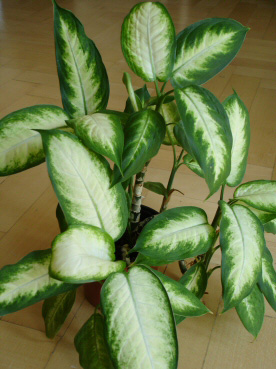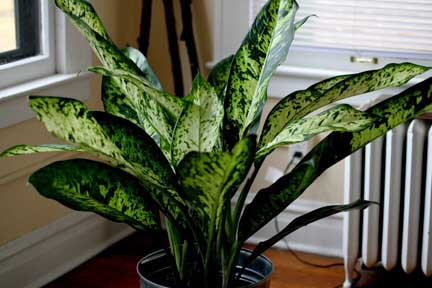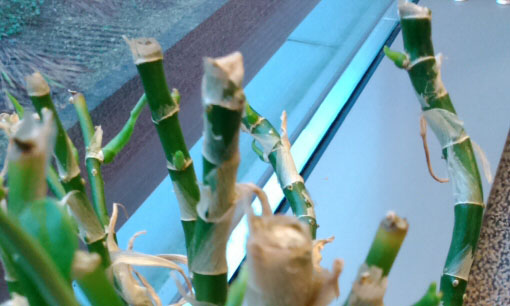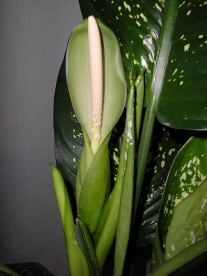





Dieffenbachia or (to use its common name) Dumb Cane has a bad reputation. It will kill your children, it will commit murder most foul and its even been known to burn down houses!  All true stories if you believe those annoying email chains / Facebook shares. The reputation isn't completely wrong, but it's undeserved and you most certainly have no need to go all Norman Bates on your Dumb Canes (these emails recommend you gather all your Dieffenbachia plants together and burn them as quick as possible!).
All true stories if you believe those annoying email chains / Facebook shares. The reputation isn't completely wrong, but it's undeserved and you most certainly have no need to go all Norman Bates on your Dumb Canes (these emails recommend you gather all your Dieffenbachia plants together and burn them as quick as possible!).
The truth is that Dumb Canes are poisonous, however it rarely kills human or animal. All parts of the plant have lots and lots of microscope needle-shaped calcium oxalate crystals and when some unfortunate animal (or person) chows down, they end up with a painful and swollen mouth. In some cases the swelling is so bad it causes the victim to go silent for inability to talk, this is where the common name of Dumb Cane came from. Although not a cold hearted killer, it does cause some very unpleasant side effects and a hefty amount of pain to go with it. Avoid coming into contact with the sap and if you do, wash it off before you accidentally rub your eye or somewhere equally unfortunate.
If you can see past this weakness you are in for a treat because Dieffenbachias have some of the most beautiful mix of green / white / yellow foliage you will ever find on an indoor plant. It's also quite versatile and will take some neglect and poor treatment, not as hardy as the mother-in-law's tongue, but certainly not as difficult as the Alocasia or Calathea. The last big plus point is that it's also fantastic at regenerating if you mess up too much and have to start over (see anything else).
There are many cultivars to choose from and unlike in some of our other plant profiles, we aren't going to list them all. D. picta "Camilla", D. picta "Exotica" and D. amoena "Tropic Snow",  are three of the most popular varieties you'll come across today, they've quite a hardy attitude in our homes and all look fantastic.
are three of the most popular varieties you'll come across today, they've quite a hardy attitude in our homes and all look fantastic.
The only all green variety is D. oerstedii and for a very mixed but more equal yellow / green balance on the leaves, search out D. bausei. Should you want to grow a very large specimen then look out for D. amoena which is sometimes commonly referred to as the Leopard Lily. D. bowmannii has humongous leaves (2ft across). If you want to see the markings on some of these plants we have put some in our photo gallery which is on the right.
Light
Another false belief about Dieffenbachia's is that they need very little light. This is actually wrong, light shade is acceptable but nothing darker. To maintain a healthy plant you should be giving indirect bright light. Too bright however and the leaves will scorch, too dark and you will be left with a leggy and sickly looking plant.
Watering
They like a really good watering then to be left alone to dry out for a bit. This is one houseplant which probably wont mind a routine watering regime. Of course always adjust according to the season and to the needs of your own Dumb Cane, for example expect in very warm months to water more often and in Winter less regularly.
Humidity
Many books and websites recommend high humidity. It may be down to the cultivars we grow personally (D. picta "Camilla", D. picta "Exotica" and D. amoena "Tropic Snow") but in our experience the plant rarely suffers if humidity is low. Red Spider Mite can be a problem in such situations though.
Feeding
Feed in the growing season at half strength every month or so.
Temperature
Warm, always warm. The plant suffers if the temperatures get to low, it would prefer to share your living areas rather than hidden away in a rarely used unheated guest room. 16°C - 27°C / 60°F - 80 °F. No lower than 10°C / 50°F (and even then this should be infrequently reached). You must also avoid draughts.
Repotting
You can repot at any time of the year but do so with caution for two reasons. The first is purely a safely issue because you are more likely to damage the leaves and release the sap when you are repotting. Consider wearing gloves or make sure you wash your hands as soon as you've finished.
The second is that many cultivars will grow tall if they are allowed to. Dumb Canes almost always look best as smallish compact bushy leaved plants, so by repotting you allow it room to grow taller and risk loosing the attractive nature of a smaller plant.
Propagation
You can somtimes divide Dumb Canes when you repot them if they're very bushy, although for the same reason why you should think carefully before repotting - when you divide you inevitably reduce the bushy nature.

Additionally as the plant gets older and taller you sometimes get bare stems or canes at the base of the plant. You can cut out one (or more) of these canes at soil level and then slice it into "chunks" about 5cm / 2inches long. Push each "chuck" into a free draining compost mix about half way in (i.e. if it's 5cm long, push it in 2.5cm), water well and then keep warm. After several weeks new growth should sprout from near the top of the bare cane (as in the picture above). If the cane you have cut off has a crown of leaves at the top, you can also reuse this by planting it into a similar compost mix.
Speed of Growth
Moderate growth.
Height / Spread
The ultimate height of Dumb Canes will be in response to the size of their pots. If you give it a large container you could be looking at 1.5m / 5ft after only a few years. Average sized pots result in a more manageable size of 0.6m / 2ft.
Flowers
 The Dumb Cane does flower indoors every once in a while but they can never match the impressive and splendor of the foliage so don't worry if yours isn't producing flowers.
The Dumb Cane does flower indoors every once in a while but they can never match the impressive and splendor of the foliage so don't worry if yours isn't producing flowers.
Anything else?
You've messed up. The temperature got too cold, you subjected the plant to draughts, you didn't water correctly or provide enough light to sustain it. All of these things (including great care + age) will result in a Dumb Cane you just want to throw out, but before you do, give regeneration a go.
To trigger this you need to cut back the stems harshly and yes for a few weeks you will have nothing more than some bare canes a few inches tall sticking out of the soil. It's not as quick as the Doctor Who version but given time new growth will emerge from the tops of these canes and voilà you'll soon have your old Dumb Cane back (check out the photo in the Propagation section above to see what we're talking about).
Stem is soft and discolored
Stem rot disease. You've most likely been overwatering and this combined with low temperatures is often too much for the plant to cope with. You should remove the effected stems, if the damage is severe you will have to discard the plant entirely (you can't reverse rotting once started). Should this be the case you could try and use the top parts as cuttings.
Brown leaf edges on Dieffenbachia
Brown edges suggest overwatering. Confusingly brown edges can also indicate underwatering. You'll know which by looking back on how you've been caring for the plant. Remember to water well then wait until the soil dries out some what before watering again. Constantly moist conditions should be avoided. If the leaf tips are brown see below for another possible cause.
Brown leaf tips / Water forming on leaf tips
Like Pothos, the Dumb Cane is a real crier. Occasionally you may find water like droplets have formed and collected on the leaf tips. This is know scientifically as guttation and is typically harmless, however this "water" also contains various salts from the plant which if left to dry can cause leaf burn resulting in brown tips. Just wick the water away with a tissue to prevent this burn.
Copyright © www.100flowers.win Botanic Garden All Rights Reserved